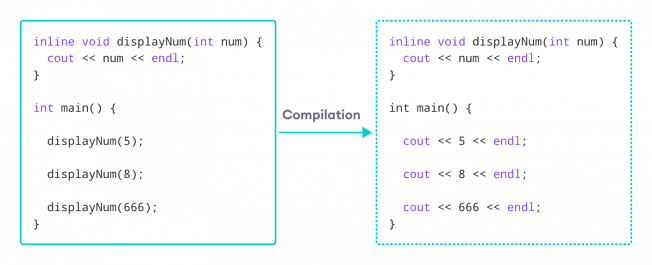In C++ Object-Oriented Programming (OOP), outside member functions provide an alternative way to define methods outside the class definition. While traditional member functions are declared within the class, outer functions offer flexibility and potential performance benefits when used judiciously.

Inline Outside Member Functions:
- You can declare a member function as inline outside the class using the
inlinekeyword followed by the function definition:
class Car {
public:
int getYear() const; // Declaration only
};
inline int Car::getYear() const {
return year; // Function definition outside the class
}
private:
int year;
};
- The
inlinekeyword suggests to the compiler that inlining the function might be beneficial (optimization decision is ultimately at the compiler's discretion). - Inlining involves copying the function's code into each call site, potentially reducing overhead compared to function call mechanisms.
Considerations:
- Inline outside functions are primarily suitable for small, simple functions where inlining would likely improve performance.
- Overusing inline can bloat the program size and negatively impact compilation time.
- Inline functions must follow certain restrictions, like having their entire definition visible and being declared
constif they don't modify object state.
Alternatives:
- Regular outside member functions: For larger or more complex functions, define them outside the class without the
inlinekeyword. - Static member functions: Used for operations not specific to individual objects but for the class itself. They are accessed using the scope resolution operator
::.
Example:
class Math {
public:
static double add(double x, double y) { return x + y; } // Static function
};
int main() {
Car myCar(2023);
std::cout << "Car year: " << myCar.getYear() << std::endl; // Inline function call
double result = Math::add(5, 3); // Static function call
return 0;
}
Remember:
- Use outside member functions strategically, considering size, complexity, and inlining's trade-offs.
- Prefer traditional member functions within the class for encapsulation and clarity in most cases.
- Leverage
constwhenever appropriate to improve performance and code quality.
I hope this explanation clarifies the use of outside member functions and inline techniques in C++ OOP! Feel free to ask if you have further questions or specific scenarios you'd like to explore.
Example:
#include <iostream> #include <string> using namespace std; class Car { private: string brand; string model; int year; public: // Constructor declaration Car(string b, string m, int y); // Member function declarations void displayInfo(); void updateYear(int newYear); }; // Constructor definition inline Car::Car(string b, string m, int y) { brand = b; model = m; year = y; } // Member function definition for displayInfo() inline void Car::displayInfo() { cout << "Brand: " << brand << endl; cout << "Model: " << model << endl; cout << "Year: " << year << endl; } // Member function definition for updateYear() inline void Car::updateYear(int newYear) { year = newYear; } int main() { // Create an object of class Car Car car1("Toyota", "Corolla", 2020); // Display initial information cout << "Initial Information:" << endl; car1.displayInfo(); // Update the year car1.updateYear(2021); // Display updated information cout << "\nUpdated Information:" << endl; car1.displayInfo(); return 0; }
Comments
Post a Comment